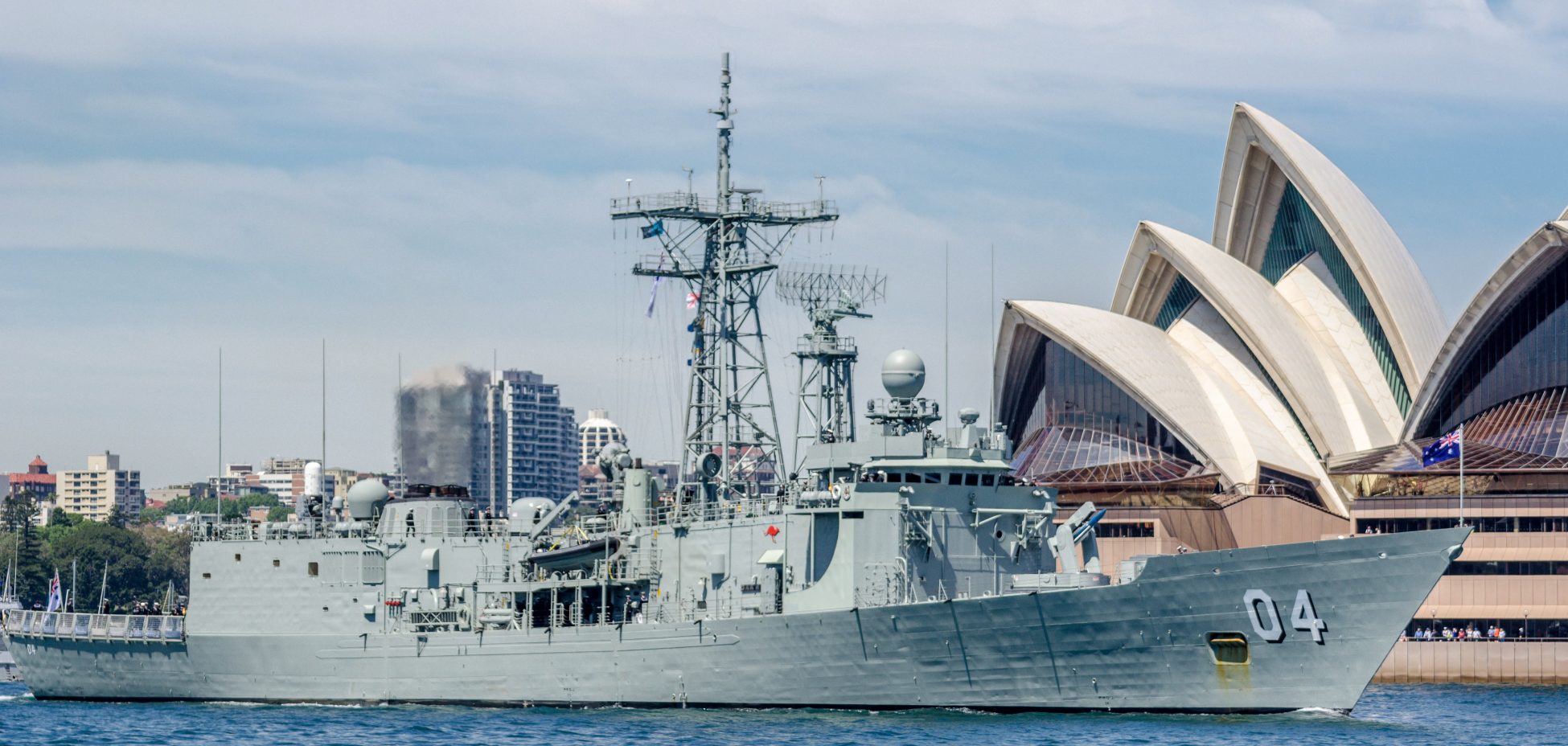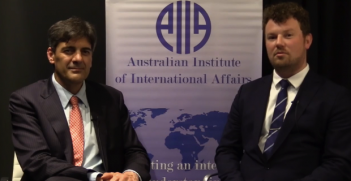Future of Navy Modernisation: An Interview With Rear Admiral Mark Campbell

The Royal Australian Navy today is headed towards a challenging era replete with the introduction of new capabilities and platforms amidst increasingly tighter budgets. In a wide-ranging interview the Head of Navy Capability, Rear Admiral Mark Campbell, spoke to defence analyst Serge De Silva-Ranasinghe about the Navy’s modernisation agenda.
Where modernisation is concerned, can you provide me with an overview of where the RAN is currently at?
Many ships in the fleet have been around for 30 plus years and there’s a requirement to renew. It’s well known that we’re getting some marvellous new capabilities that’s already in production – ships like the new Air Warfare Destroyers (the Navy refers to these as ‘DDGs’ [NATO term for Guided Missile Destroyer]), which are being built in Adelaide. They’re a long way down the track. The new LHD [Helicopter Landing Dock ] is already fitting out in Melbourne. So that’s part of the modernisation process; the DDG will be replacing our older Oliver Hazard Perry Class FFG [Guided Missile Frigates] and, in part, the ANZAC Class Frigates. The FFG ships are getting pretty old, so that part of modernisation is simply about replacing older vessels. We also need to replace several of our other vessels including a major part of the afloat support force, HMAS Success,which isgetting fairly long in the tooth.
We had some indifferent press post the release of the Rizzo Report of a few years ago. The Navy needs to avoid revisiting some of the challenges of the past that the Rizzo Report was critical of. We bought some older ships in the past that we kept going for a long time – longer than some would suggest was wise. Nevertheless we will keep extending ships. We have commenced work to extend our survey motor launches and we also need to extend some of our other auxiliary vessels such as our Minehunters. We will extend ships where it makes sense to do so, where the hull is ok,and the systems are still ok. But where it is not cost effective to extend ships, such as with the afloat support ships, we’ll get new ones.
In relation to the Air Warfare Destroyer and the LHD, can you tell us why a Spanish company was selected to build the capability?
There wasn’t a strategy of buying Spanish vessels necessarily. Navantia designs were put up in competition with several other designs as part of the normal acquisition process for both programs. Other designs were also put forward. It just so happened that Navantia designs won both competitions. There was no particular desire to suddenly start buying European or to not buy American. It was just they won the competition fair and square. That’s the way Australia does business. We hold ourselves up as being a Defence Force that is committed to open and fair tendering, in fact this is an across the Government directive that we’ve got to have open and fair processes in place. SEA 4000 [the AWDs] and Joint Programme 2048 [LHD] were two such programs that were won by Navantia designs. And it’s fair to say that we have since developed a close working relationship with the Spanish Armada, in fact it’s a very good, close relationship now and I get to talk to the Spanish fairly regularly. The Chief of Navy and Deputy Chief of Navy also talk fairly regularly to their counterparts as well. The Spanish Armada is a mid-sized navy in a different part of the world but with a similar outlook to Australiaand a similar size to Australia.
To what extent has a capability gap materialised by the retirement of the Perth-class Guided Missile Destroyers in 2001?
It has. The old Charles F Adams Class DDG in RAN service was a fantastic capability which we improved greatly over that which was resident in the US Navy and we were very comfortable with that ship. But they were getting very old and we had to replace them. So it did leave a gap. I would point out the FFGs always did have Standard Missiles, SM-1s, and it was always a capable ship in a self defence role. But I think we’re moving with the times quite satisfactorily, we’ve got SM-2 into the FFG Class now, we’ve got the evolved Sea Sparrow into the ANZACs and we’re feeling more confident with the DDG on the horizon that we are on the way back into the anti-air warfare game.
Where modernisation of the ANZAC-class frigates is concerned, could you give an update on what’s happening? Is this as an appropriate air defence capability until the delivery of the Air Warfare Destroyers?
The ANZAC Anti-Ship Missile Defence (ASMD) Project isn’t designed to either replace or stopgap for the DDG in an air-warfare sense. It’s a stand-alone project in its own right. The FFG, the Oliver Hazard Perry/Adelaide Class, that we have fitted with SM2 [the RIM-67 surface to air missile as part of the Aegis system] is more the interim anti-air warfare vessel in our inventory while we await the Air Warfare Destroyers. Our ANZAC-class ASMD upgrade does give us a marvellous defence capability which was proven in Hawaii last year. And we’re quite excited by the level of capability that ANZAC ASMD brings to the party. But the SM2 capability in the FFG is the Navy’s primary Anti-Air Warfare capability until the DDG comes online in a few years time.
In relation to the Armidale-class and its replacement; how long can they remain operational before a replacement vessel will be absolutely necessary?
We’re quite confident that we can keep the Armidale’s operational for many years to come. The Rizzo report talks about a bathtub curve of cost of ownership. At very early stages it costs you a lot to run a new platform and then you get all the bugs out of it and it becomes cheaper and then, towards the end of its life, it becomes more expensive again as parts become obsolete or systems become obsolete. Those parts become harder to find and I suspect that we’re starting to climb the other side of the bathtub curve with the Armidale Class. Having said that, we can keep the Armidale going for quite some time yet. They are being worked very hard at present on a national task that’s keeping our people busy and those boats busy. The Defence White Paper 13 pointed to the Government’s desire to replace them with a proven vessel to ensure that we can provide the patrol capability that the Government requires. There is a lot of work going on in the Armidale replacement space at the moment.
On the topic of naval aviation, a 2010 Australian Strategic Policy Institute (ASPI) report claimed that the RAN’s capacity in this area was “below state of the art”. Your response?
I haven’t read that particular ASPI report about naval aviation, but when you think back to 2010 you’d have to say that that’s probably a fair enough assessment. Back in 2010 we had the classic Seahawk which was 20 years old at that stage and we also had the aging Sea Kings which are now out of service. The [Eurocopter] Squirrel was also 25-30 years old at that stage. So it was an aging fleet in 2010. It was still well looked after with plenty of life left in it but the designs were quite old and restrictive. When you roll the clock forward three years, we now have the MRH 90 in service; they’re still undergoing trials but we have one flight at sea at present. And we also have a flight on a New Zealand ship at present undergoing first of class flight trials. The MRH-90s are an all carbon fibre helicopter, very modern systems, a great quantum leap over the Sea King. We’ve also got the AIR9000 Phase 8, the Romeo version of the Seahawk helicopter, which is about to enter service in a year’s time. The first one will be delivered towards the end of this year and they will be in service in Australia at the end of next year. AIR9000 Phase 7, the helicopter aircrew training system replacement for the Squirrel, is well down track and should achieve second phase next year. Basically we have taken a great step forward in a couple of years.
On the subject of submarines, do you really believe that the RAN will acquire 12 submarines? Even if these submarines are indeed acquired, can they be adequately manned anyway? It seems quite an ambitious goal.
At the last election both sides of politics stated that 12 submarines was the goal. The Government has since decided that the number of submarines to be procured will be considered by the White Paper and Force Structure Review which will provide an answer in mid-2015.The future ship-building paper that came out with White Paper 13 suggested a continuous build approach. To produce the effect for 12 submarines you might need a continuous build of a lesser number depending on the parameters of the continuous build. There is a lot of work required in this area and we still have that ahead of us. I know how many submarines that we need; we certainly need more than we currently have. As for the manpower question, I’m pretty confident that we can man them when we get them because we’ll have plenty of time to work on the workforce. Let’s face it, we’re not looking at something any time in the next 15 years at the moment, so that gives us plenty of time to man up for the number that the Government decides upon. I’m quite confident that we’ve got the ability to do that. I’m fairly confident that we’re not going to have the same number of personnel in the Future Submarine as we do on Collins. All this work is being done now.
Obviously, should more submarines enter into service there will be more strain on existing facilities. How will the RAN likely accommodate the new submarines where base facilities are concerned?
There are several facilities being planned to support the Future Submarine Project. There’s an engine test facility and a combat systems centre. The Government has hinted at the likelihood of facilities in three states. There’s certainly going to be additional facilities built in Adelaide. Our home porting in Western Australia isn’t going to change, I don’t believe, and there are additional facilities also forecast for Western Australia. There has been a suggestion of facilities to be built in Melbourne. I’m not sure whether that will occur but there’s certainly going to be additional facilities and support. We’re very keen to learn from the lessons of the Collins project and we’re going to move forward with the SEA1000 Future Submarine Project to ensure that we do it better than Collins.
To what extent has the Australian Submarine Corporation been overburdened by its mandate to build the Hobart-class and eventually the Future Submarine Project to realistic timeframes?
ASC is working hard to sustain Collins and they are also working very hard to produce the Hobart Class DDG. The Air Warfare Destroyerconstruction is being managed by an alliance and the Australian Submarine Corp is just one member of the Alliance. The DDGs are being built at the ASC facility in Adelaide. Although you can draw some dots, and I’m not going to draw dots at the moment, no selection has been made as to which particular company might build or design the Future Submarine. So at present, from the Navy perspective, Australian Submarine Corporation is working on sustaining Collins and this area has been steadily improving since the release of the Coles Review report. We have three boats running at present which is a good outcome compared to where we have been in this area. I think we’re going to have a fantastic capability in the Hobart-class DDG. There is going to be a lot of work to do heading towards the SEA1000 Future Submarine and so we shall have to wait and see how much work, if any, that ASC will be given in that project.
Since there is now a strong focus on developing a Navy that is capable of integrating with the Army in the sphere of amphibious operations, what challenges has this presented to your command?
There’s a lot of work going on in that area. In order to execute the ADF strategy to realise the new amphibious force the Chief of the Defence Force designated the Chief of Navy (CN) as the lead Capability Manager. The Commander of the Deployable Joint Force Headquarters was also jointly appointed by CN and the Chief of Army (CA) as responsible to realise the joint amphibious capability. I co-chair the Joint Amphibious Council with Major General Jeff Sengelman, of Army Headquarters to guide and provide oversight to achieve the desired fully integrated amphibious capability and ensure that risks and issues are worked through to have an effective amphibious ready element available for Exercise Talisman Sabre 2017. We will have a smaller capability ready in 2015 but by 2017 it’s designed to be a full amphibious demonstration of the ADF capability. The Army are not marines and are not used to working in ships in a general sense, but that is changing rapidly. We’re also having more of the Army aviation capability practice with ships like Choules and Tobruk. So it is a major education program in a sense. Has it presented any difficulties? Yes, quite a few. And some priorities have to be monitored. But General Sengelman and I are working through the issues and I’m upbeat that we’ll deliver what the Government expects in 2015 and 2017. We don’t underestimate the complexity or scale of realising the whole amphibious force by 2017, but I’m quietly confident.
Out of curiosity, while on the topic of amphibious warfare, has there been any debate within the Navy to raise naval commandos or even amphibious infantry?
No there has not been. In fact I’ve been in this job now for nearly two years and no, that hasn’t been raised at all. Since the ADF became the ADF it hasn’t just been the individual services, it’s seen itself as being a joint force. We have had commandos in the Army and the Navy clearance divers do have close links with the Army, but I do not think we’ve ever had Royal Marine equivalent, though some historian will probably correct me down the track. It was our Army who did the amphibious work in World War II for instance so I think that it is history playing against it more than anything else. It’s never seemed to stop us doing anything though.
Given that you’ve been in your role as Head of Navy Capability since 2012, what are your plans for the rest of your tenure in this area?
I’m coming up to the end of year two in my job. My term as Head of Navy Capability is quite short when you look at the life of a ship. I’ve been in the Navy for almost 35 years and there are several ships and helicopters that have been around as long as I have. My aim is always to be focussed on the long term goals of making sure we improve the fleet, keep it as flexible as we can to improve the sustainability and capability of it in the way the Rizzo Report suggested as cost effectively as possible. I think part of my remit is to make sure that we take as robust an approach to managing the capability as we possibly can. I came into this job from the Defence Material Organisation and I knew a little about maintenance at an operational level and also deeper maintenance levels. I am trying to apply some of the things I learned in the DMO in terms of maintenance and asset management to improve the way that we modernise the fleet. So there is plenty of work to do, it is a great honour to have the opportunity to be in this position to be able to contribute and I’m looking forward to the work ahead.

RADM Mark Campbell
Thanks for the opportunity Admiral.
Sergei DeSilva-Ranasinghe is a security analyst, defence writer, consultant and Perth-based non-resident fellow affiliated with the National Security Institute, University of Canberra.





